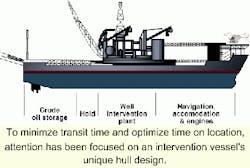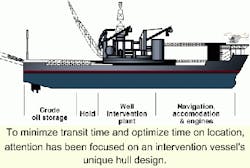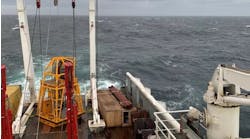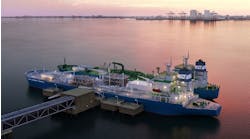As the push into greater water depths gains momentum, how to perform intervention services on wells with subsea trees looms ominously over future devel op ment projects. Intelligent completions have been one option to meet part of the challenge, but this technology has matured slowly and has not played a significant factor in deepwater field development decisions to date.
Another alternative has been to use a semisubmersible from the existing fleet to move on location and perform the intervention services. While one of the easiest methods, it is definitely not the cheapest. This option depends greatly on availability of a semisubmersible, and if drilling activity experiences an increase, rig availability will decrease and render this solution even more expensive and less likely to happen.
One of the other, and more innovative, solutions is to use coiled tubing from a mobile monohull ship, whether a converted workover vessel or a specially-built rig.
Growing need
The latest estimates are that approximately 750 subsea wells exist in the North Sea alone. Indications are that many more subsea development solutions will be implemented in the coming years, creating an increased need for well intervention capabilities.
Recent estimates predict a 60-80% increase in annual subsea installations for the next several years. With the current number of installations at slightly over 105 per year, this suggest a critical decision will have to be taken on two issues: conventional versus horizontal trees, and a greater investment in future smart well technologies or alternatively "right-now" well intervention technologies.
Two types of subsea well workovers/interventions, heavy and light, are used today:
- A heavy subsea workover requires a drilling rig and all of its capabilities - mainly for running a marine drilling riser.
- A light intervention is performed through existing tubing with coiled tubing or wireline and through a light riser. Currently, light subsea interventions are performed with semisubmersible drilling rigs and portable equipment placed on the deck of the rig.
To address the need for intervention, a low operating cost vessel capable of high transit speed, low maintenance, minimal drydocking requirements, low fuel consumption, and large operating window in water depths between 75 meters and 2,000 meters is needed. These criteria quickly lead to the decision that a mono-hull design vessel would be the most cost effective alternative; but not without some compromising and optimization of supporting systems.
A mono-hull requires re-engineering of critical hull design aspects, such as incorporating square bilges and installing passive-roll stabilization tanks under the main deck, in order to minimize vessel roll tendencies. This results in a hull design with almost no roll in wave periods up to 14 seconds - beyond that for Gulf of Mexico, North Sea, and West of Shetland spectral peaks. The downside of this hull design is that its maximum speed is lower than the absolute minimum specified in the preliminary operational requirements.
The answer to this design problem was found by looking at the specifications for Mississippi River and Rhine River barges. In-route transit speeds are improved if all spare power is diverted to the stern thrusters. This resulted in the selection of the largest thrusters and open propellers available. Improved performance and an almost roll free hull, capable of 16 knots was the result. This roll-free hull also allows selection of a directional heading, optimizing the balance between pitch and heave. Theoretically, this widens the operational window to 6-meter seas (Beaufort 7-8).
Split-facility and redundancy philosophies are exploited in the power management structure of the vessel. The crucial need for emergency disconnection power, while maintaining minimum DP requirements has resulted in a six-engine arrangement for a total installed power of 21 MW. Derrick power is derived from two independent hydraulic power packs and two different switchboards.
Riser selection
There was consideration initially to use a 7 3/8-in. bore riser to accommodate new horizontal tree systems. This was downsized to a 6 3/8-in. bore riser, with the capability to install a purpose-designed plug retrieval unit (run on bottom of the mono-bore riser) to recover 7-in. crown plugs. The current number of 7-in., horizontal trees installed, extra mechanical support, small annular flow areas, and lighter weight of the smaller riser drove the decision making process. Lateral support of coiled tubing within a smaller riser is greatly improved, reducing the chance of buckling. Smaller annular volumes yield better hole cleaning capability and less storage volume required on the rig.
The lower riser package (LRP) and emergency disconnect package (EDP) are a dual bore, 7 1/16-in. by 2 1/16-in., arrangement, with a bore selector on top of the EDP. The combination of a lower stress joint above the LRP, combined with a ball joint just below the vessel provided the optimum riser stability and fatigue results. Subsea package control is via an electro-hydraulic multiplex system and seabed accumulation.
Two moon pools were designed into the rig to allow for simultaneous riser-building and wellhead preparation operations and to avoid pulling the riser for tree or module change out. A mezzanine deck near the derrick allows for coil installation while riser-building operations are in progress, reduces coil fatigue, and eliminates the need for reel heave compensation. The 250-ton derrick can hold up to 1,000 meters of racked riser.
Intervention equipment
Flexibility of operational scope has been the prominent philosophy throughout the ship design process. A large versatile deck area was seen as advantageous to the varied requirements of well intervention and subsea construction work. Everything from simple storage areas (up to 1,250 square meters of free deck space), space for small processing facilities, and crude oil storage benefited from this careful planning. Crude oil storage capability is 10,000 bbl, divided into 3 tanks. The center (2,500 bbl) tank is specially coated for well effluent, corrosive fluids, and spent acids. Two 200-hp and two 700-hp pumps are located in two different locations, and power controlled independently.
Coiled tubing and wireline equipment are placed on the heave compensated, working mezzanine deck, reducing coil fatigue, and allowing injector, slickline, electric line, and two spare rolls of coil to be stored. Coiled tubing is considered a consumable item, resulting in the vessel's capability to easily change out rolls while at sea.
The design is such that a reel from the aft deck can be moved through the derrick, to a lower deck, where it is then lifted onto the working mezzanine deck. Very large diameter coil reels can be left on the aft deck and fed directly to the derrick and injector head, freeing up space on the working mezzanine deck.
The control room location is situated so the main operator maintains clear sight of the injector head, reels, wireline equipment, and derrick. This is a huge safety advantage and another result of the vessel's thorough planning. The vessel is currently defined as a mobile offshore installation, and not licensed to operate in UK or Norwegian waters until safety cases are formally accepted by both of those governments.
Cost estimates for this proposed vessel are in the $100 million range. To recover the capital investment, vessel utilization will have to be very high - at least 90% of the year under contract. Operator commitments are currently being solicited from various operating regions around the world. Current utilization commitment estimate is about one third of a year.




